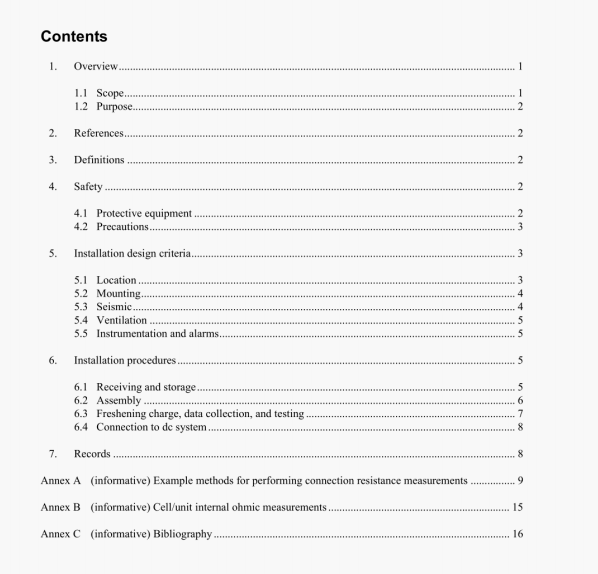IEEE Std 484:2002 pdf free download.IEEE Recommended Practice for Installation Design and lnstallation of Vented Lead-Acid Batteries for Stationary Applications.
6.1.2 UnpackIng
a) When lifting cells, a strap and strap spreader should be used, if applicable.
b) Always lift cells by the bottom, never by the cell posts.
C) Check electrolyte levels for evidence of leakage and to ensure that the plates arc covered. Any cell should be replaced if the electrolyte level is 13 mm or more below the top of the plates. lithe level is less than 13 mm below the top of the plates, add distilled or other approved quality water (or electrolyte approved by the manufacturer). Fill to above the top of the plates.
d) All cells with defects, such as cracked jars, loose andor lifted terminal posts, or cracked, broken or improperly aligned plates. should be reported to the manufacturer for resolution or replaced as needed.
6.1.3 Storage
a) Cells should be stored indoors in a clean, level, dry, and cool location; extremely low or high ambient temperatures or localized sources of heat should be avoided.
b) Cells should not be stored for more than the time period recommended by the manufacturer, without applying a charge to the battery; in all cases, a period of 3 months storage is allowable between charges if the recommendations of item a) of this subclause are followed.
c) For charging during storage or special conditions, the battery manufacturer should be consulted. Record dates and conditions for all charges during storage.
6.2 Assembly
6.2.1 Rack assembly
The assembly of the rack should be in accordance with the manufacturer’s recommended procedure.
6.2.2 Cell mounting and connections
The following sequence should be used:
a) Lift the individual cells onto the rack following the procedures outlined in item a) and item b) of 6,1.2. Mount the cells in accordance with the manufacturer’s recommendations. Do not apply lubricant on rack rails unless approved by the manufacturer(s).
b) Remove shipping plugs and install flame arrestor vent plugs. Shipping plugs are designed to ventilate the battery during rraiisit and storage. The shipping plugs will be needed it’ the batteries are reshipped for reuse or recycling. (‘onsideration should be given to retaining the shipping plugs after neutralizing residual acid deposits.
C) Check cell polarity for positive to negative connections throughout the battery.
d) Unless otherwise instructed by the manufacturer, clean all terminal posts of corrosion-inhibiting compound. Neutralize corroded areas with a bicarbonate of soda solution and dry. Remove any remaining dirt or corrosion with a nonmetallic brush or pad: then promptly coat all areas with a thin film of the manufacturer’s approved corrosion-inhibiting compound.
IEEE Std 484:2002 pdf free download
